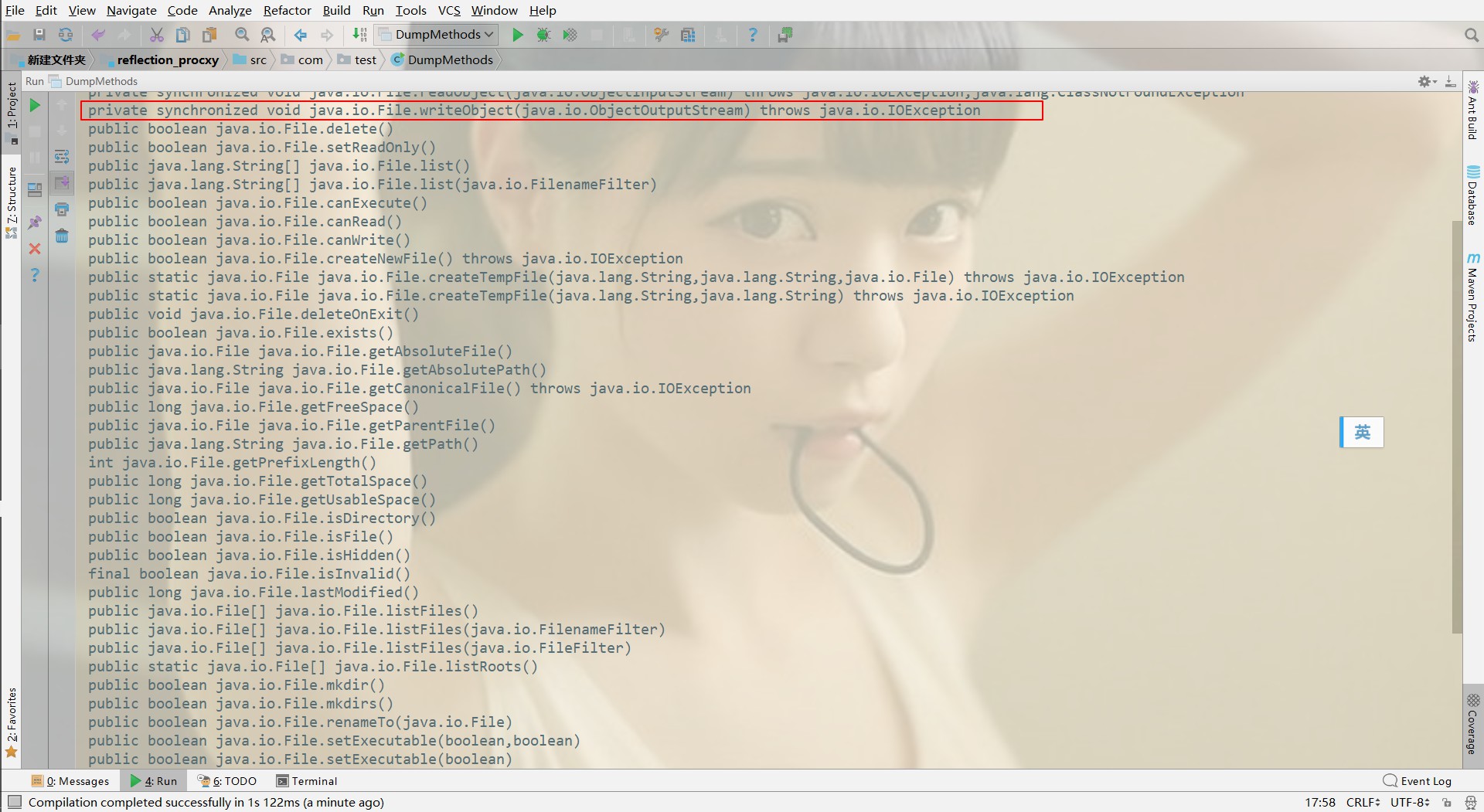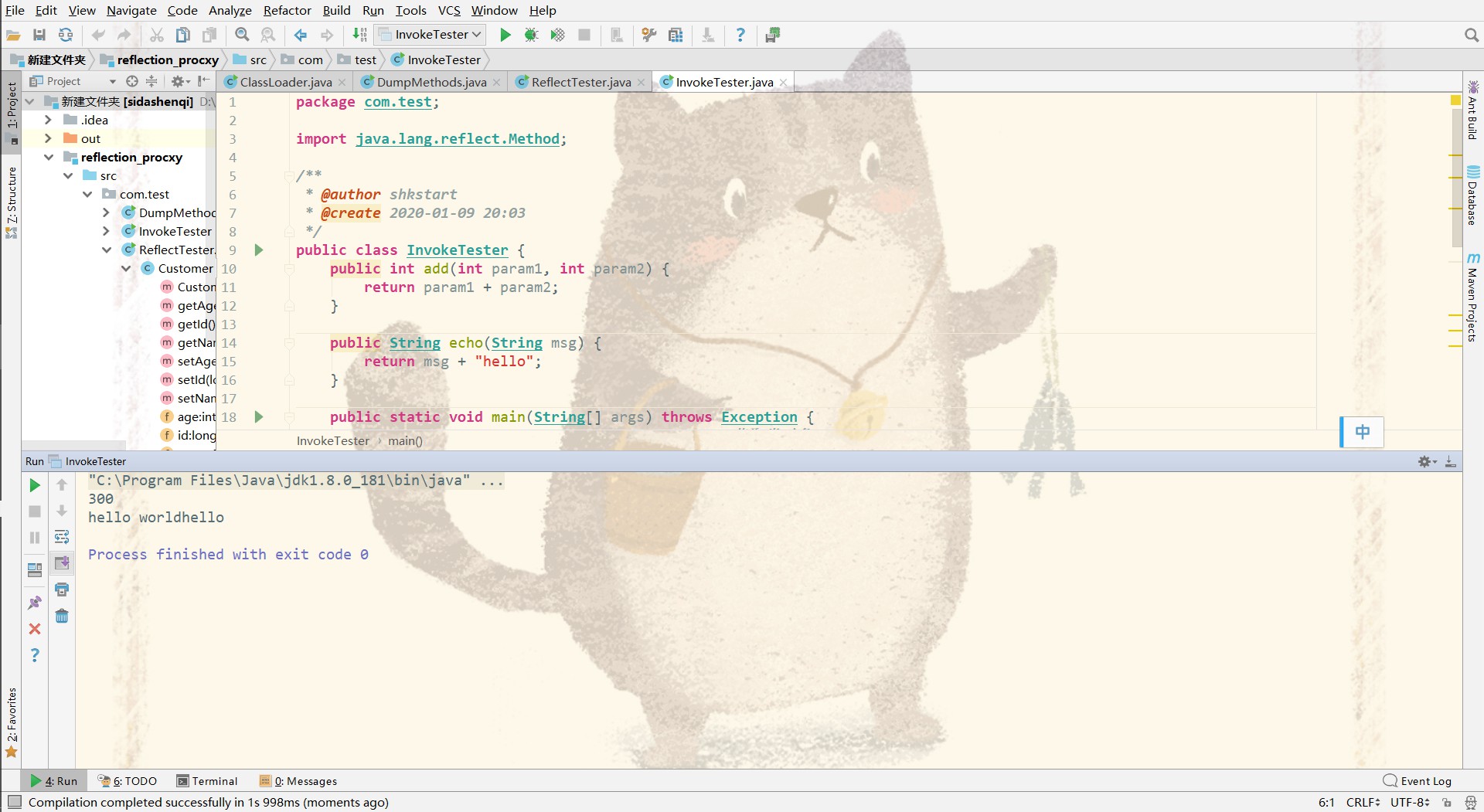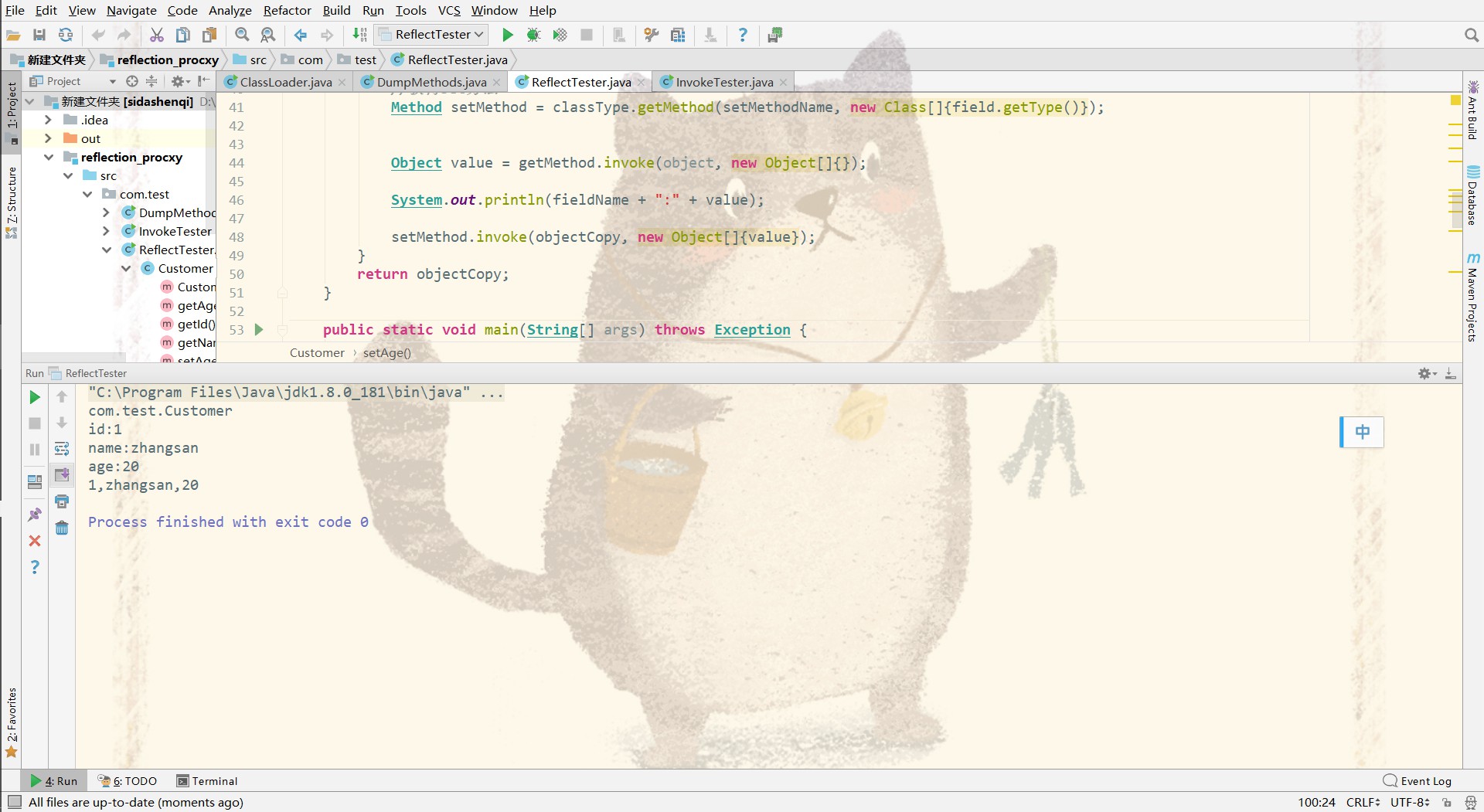Java反射机制,是一个基础的内容章节,在对于之后的框架学习中起到了至关重要的作用,现在比较流行的是spring
框架 ,其中的IOC(自动注入)以及AOP(动态代理),在AOC中代理模式又分为动态代理和byteCode
instrument(插桩)或者是CGLIB 。
在学习Java反射机制前,首先问一个问题:在Java运行时,对于任意一个类,能否知道这个类有那些属性和方法?对
于任意一个对象,能否调用它任意一个方法?
答案是肯定的。可以!
在这里要去区别一个事情:如果说在自己写的类中去改一个数据类型或者说属性,那只是在编译时,并不是在运行
时。
反射机制的几大功能:
一般而言:程序运行时,允许改变程序结构和变量类型成为动态语言。由此可见Java并不是动态语言,但是Java有一
个动态相关的机制Reflection,可以运行时加载、探知、使用编译期间完全未知的classes(但是methods定义不知
道)。所以Reflection是Java视为动态语言的关键性质,允许在程序运行时通过Reflection APIs 取得任何一个已知名
称的class的内部信息。(包括父类,接口,变量,方法等)。
接下来我们用代码来举一个例子。
public class DumpMethods {
//从命令行接受一个字符串(该字符串是某个类的全名)
//打印该类的所有方法
public static void main(String[] args) throws ClassNotFoundException {
//class类是所有反射的入口
Class<?> classType = Class.forName(args[0]);//编译时不知道args是什么?
Method[] methods = classType.getDeclaredMethods();
for (Method method : methods) {
System.out.println(method);
}
}
}
在这里,我们可以看到,Java虚拟机并不知道你所要传入的参数是什么,这个时候我们类的全类型名
称 Java.lang.String输入进去,我们可以看到如下图片

其中,标红的那一行可以看到,直接将私有的方法也可显示出来。这一个是非常有用的。那么这些代码就可以很明显
的让我们知道,在Java运行时,就可以判断任意一个对象所属类。
接下来,我们来看一下反射的相关代码:
public class InvokeTester {
public int add(int param1, int param2) {
return param1 + param2;
}
public String echo(String msg) {
return msg + "hello";
}
public static void main(String[] args) throws Exception {
Class<?> classType = InvokeTester.class; //获取类对象
Object invokeTester = classType.newInstance();//创建此 Class 对象所表示的类的一个新实例。
//调用前提是 必须有一个不带参数的构造器
//以上两行代码就相当于new invokeTester
Method addmethod = classType.getMethod("add", int.class, int.class);//确定这个方法需要输入 方法名 参数
Object result = addmethod.invoke(invokeTester, new Object[]{100, 200});
//以上两行相当于i.add(100,200)
System.out.println((Integer) result);
Method echoMethod = classType.getMethod("echo", new Class[]{String.class});
Object result2 = echoMethod.invoke(invokeTester, "hello world");
System.out.println((String) result2);
}
}
在这里,着重说获取类对象时,创建的class对象新的实例时,必须有一个不带参数的构造器,否则会报错,那么怎
没有应该怎么办呢?下面会讲到。确认一个方法,我们通过重载机制就可以知道,需要通过这个方法的名字和他的参
数来确认。上一个我们通过classType.getDeclareMethods()来获取了所有方法,而现在我们可以通过
classType.getMethods()方法来获得这个我们需要已知方法的名字,在这里参数类型是int.class,String.class.在之
后,我们通过revoke方法,来获得我们调用方法的结果,invoke方法中的两个参数,第一个参数是我们需要调用的对
象,第二个参数就是调用方法的参数,这个参数应该与getmethod方法的参数所写的类型一致,下面我们来看一下结
果:

我们通过这个例子,就可以发现,通过反射机制我们完全可以调用一个方法。
接下来,整一个复杂点的!
public class ReflectTester {
public Object copy(Object object) throws Exception {
Class<?> classType = object.getClass();
System.out.println(classType.getName());
Object objectCopy = classType.getConstructor(new Class[]{})
.newInstance(new Object[]{});
//相当于是 object object2 = classType.newInstance();
//获得对象的所有属性
Field[] fields = classType.getDeclaredFields();
for (int i = 0; i < fields.length; i++) {
Field field = fields[i];
String fieldName = field.getName();
//获得属性的首字母并转换为大写
String firstLetter = fieldName.substring(0, 1).toUpperCase();
//获得和属性对应的getxxx()方法
String getMethodName = "get" + firstLetter + fieldName.substring(1);
//获得个属性对应的setxxx()方法
String setMethodName = "set" + firstLetter + fieldName.substring(1);
//获得get方法
Method getMethod = classType.getMethod(getMethodName, new Class[]{});
//获得set方法
Method setMethod = classType.getMethod(setMethodName, new Class[]{field.getType()});
Object value = getMethod.invoke(object, new Object[]{});
System.out.println(fieldName + ":" + value);
setMethod.invoke(objectCopy, new Object[]{value});
}
return objectCopy;
}
public static void main(String[] args) throws Exception {
Customer customer = new Customer();
customer.setId(new Long(1));
customer.setName("zhangsan");
customer.setAge(20);
Customer customerCopy = (Customer) new ReflectTester().copy(customer);
System.out.println(customerCopy.getId() + "," + customerCopy.getName() + "," + customerCopy.getAge());
}
}
class Customer {
private long id;
private String name;
private int age;
public Customer() {
}
public long getId() {
return id;
}
public void setId(long id) {
this.id = id;
}
public String getName() {
return name;
}
public void setName(String name) {
this.name = name;
}
public int getAge() {
return age;
}
public void setAge(int age) {
this.age = age;
}
}
以上代码创造了一个Customer类,并通过反射进行了一次copy,调用getter,setter方法,成功。此处一定要在
Customer类中写入构造器,否则容易造成权限不通过导致没有办法读取。我们可以看到 Object object copy =
classType.getConstructor(new Class[]{}) .newInstance(new Object[]{});这一行代码就相当于是object object2 =
classType.newInstance();如果没有无参构造器时,则可运用这个方法

原文:https://www.cnblogs.com/xiaobaoa/p/12178508.html